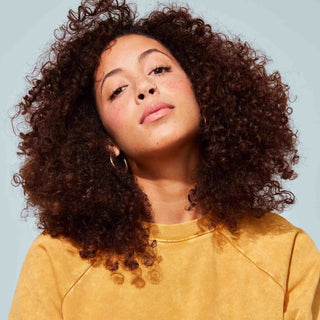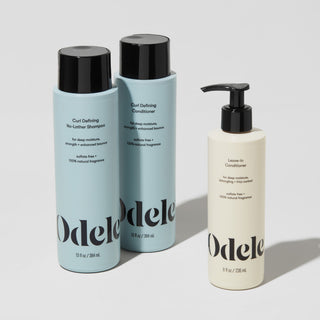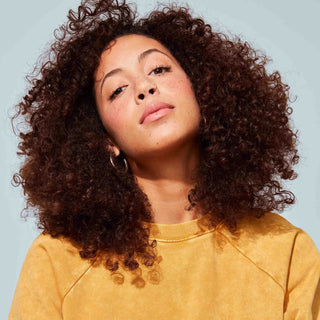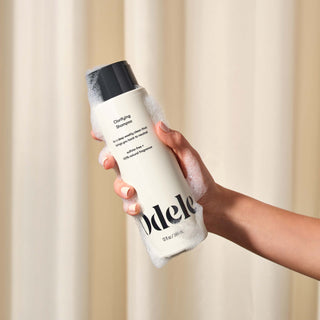If you’ve spent any time in the curly-hair corners of the internet, chances are you’ve come across co-washing. Short for “conditioning wash,” it’s a way to cleanse your hair with conditioner instead of traditional shampoo.
Co-washing has long been a staple for curly and coily hair types—but it’s been catching on beyond the curl world, too. As more people look for gentler ways to wash, co-wash vs. shampoo has basically become the new “how often should I wash my hair?” debate.
So what’s the deal with co-washing, and is it right for your routine? We break down everything you need to know.
Co-wash vs. shampoo
What is shampoo?
We all know shampoo: it’s formulated to lift away buildup using surfactants, cleansing agents that attract both oil and water. One end of a surfactant molecule binds to oil, sweat and product residue; the other binds to water, helping everything rinse away.
That process keeps your scalp clear and healthy. Removing buildup supports healthy growth and helps your hair absorb the moisture and nutrients from conditioners and treatments.
But not all shampoos strike the same balance. Some use stronger surfactants (like sulfates) that can over-clean, stripping natural oils along with buildup. Gentler, sulfate-free formulas—like all Odele shampoos—clean just enough, leaving your scalp fresh and your strands balanced.
What is co-wash?
Co-washing is a cleansing method that uses a co-wash formula or cleansing conditioner instead of traditional shampoo. It works because most co-washes (and even some conditioners) contain mild cleansing agents called cationic surfactants. (You’ll often spot them on the label as cetrimonium or behentrimonium chloride.)
When mixed with water, they attract small amounts of oil and residue while coating hair in moisture. The result is a light cleanse that refreshes your hair without removing the oils that keep it soft and defined.
That’s great news for curls, coils and color-treated strands that crave moisture—but less ideal for fine, oily or buildup-prone scalps, which usually need a deeper reset.
In short: co-washing isn’t a replacement for shampoo—it’s a companion to it.
And these days, it’s not an either/or situation. There are also in-between cleansers that sit right in the middle—like our Curl Defining No Lather Shampoo, a low-suds wash that leaves curls and coils clean and deeply hydrated.

Pros and cons of co-washing
The pros:
-
Hydration, hydration, hydration. Co-washing keeps your natural oils intact, helping curls and coils stay moisturized and defined.
-
Less frizz, more shine. By skipping stronger surfactants, co-washing smooths the cuticle and leaves hair soft and glossy.
-
Gentler on color-treated or damaged hair. Gentle cleansing = less fading and breakage.
-
Good for in-between days. Co-washing is the perfect refresh between full shampoos.
The cons:
-
Can cause buildup. Without regular shampooing, oil and product can accumulate, especially on fine or oily hair.
-
May leave hair heavy or coated. Those moisturizing ingredients can weigh some textures down.
-
Not a full cleanse. Even if you’re co-washing, shampoo is still important for scalp health.
Is co-washing right for me?
Co-washing shines on hair that’s dry, textured or fragile—types that crave moisture most.
Ideal for:
-
Curly or coily hair: These textures are naturally drier because oils move slowly from root to tip. Co-washing helps retain hydration and definition between washes.
-
High-porosity or damaged hair: When the cuticle is lifted, co-washing helps smooth roughness and reduce breakage.
-
Color-treated hair: Gentle cleansing keeps color vibrant longer.
Less ideal for:
-
Fine or oily hair: Co-washing can leave hair limp or coated.
-
Low-porosity hair: Moisture may sit on the surface instead of absorbing.
-
Scalps prone to buildup: You’ll still need a full cleanse to keep things balanced.

How to co-wash hair
Most stylists agree: don’t ditch shampoo—alternate. Co-wash between shampoos if you’re looking to refresh and revive your hair without a full wash day.
Here’s how to get the most out of the co-wash method:
-
Use a true co-wash or cleansing conditioner, not a regular conditioner. A true co-wash contains mild cleansing agents designed to remove light buildup. Regular conditioner is meant to hydrate, not clean, and can leave residue behind.
-
Focus on your scalp. Work the product into your roots and down your lengths, massaging with your fingertips for at least a minute to loosen oil and buildup before rinsing.
-
Rinse thoroughly. Really thoroughly! It’s easy to leave behind product if you rush.
-
Rotate in a clarifying shampoo. Use our Clarifying Shampoo every few washes for a full reset.
-
Pair with scalp care. Prone to buildup or flaking? Reach for our Scalp + Body Scrub followed by Rejuvenating Scalp Serum to help keep your scalp balanced.
- Finish with a leave-in. Our Leave-in Conditioner locks in moisture without heaviness.

How often to co-wash hair
There’s no one-size-fits-all schedule—your ideal rhythm will depend on your texture, scalp and lifestyle.
-
Curly, textured, or dry hair: 2-3 times per week to maintain moisture.
-
Fine or oily hair: You may find co-washing too heavy. If you want to experiment with it, start sparingly and rotate with a clarifying or volumizing shampoo.
-
Active lifestyle: Co-wash as needed, especially after workouts—just be mindful of buildup.

Co-washing FAQs
Is co-washing the same as using conditioner to wash your hair?
Not quite. A true co-wash (or cleansing conditioner) includes mild cleansing agents that remove light buildup. Regular conditioner isn’t formulated to clean your scalp, so using it in place of shampoo can lead to residue over time.
Can I co-wash instead of shampooing?
You can, but most stylists recommend alternating. Co-wash between shampoos to maintain moisture, and use shampoo every few washes to fully reset your scalp and hair.
How often should I co-wash my hair?
It depends on your hair type. Those with curly, coily or dry hair may benefit from co-washing 2-3 times per week, while those with fine or oily hair may prefer once a week or as needed.
Is co-washing good for fine hair?
Co-washing tends to work best on dry, damaged or textured hair—it may not be cleansing enough for fine or oily strands. If you have fine or oily hair and see great results from shampoo, stick with what works for you.
What’s the difference between co-wash and low-poo?
Both are gentler alternatives to traditional shampoo, but they’re not the same.
-
Co-wash: Cleanses with conditioning ingredients and mild surfactants. Little to no foam, extra moisture.
-
Low-poo: Uses lightweight, sulfate-free surfactants for a low lather and a more thorough cleanse.
If you need deep hydration and a reset, a low-poo (like our Curl-Defining No Lather Shampoo) can be a great middle ground.
What’s the best shampoo to use if I co-wash?
A gentle, balancing formula like our Clarifying Shampoo is perfect for resetting your scalp between co-washes. It removes residue without stripping moisture, and it’s made for all hair types.
The Drop
Co-washing can be a useful reset between shampoos—especially for dry or textured hair that thrives on moisture. It helps refresh your hair between washes without over-cleansing. But for long-term hair and scalp health, shampoo is still essential.Looking for the right cleanser for your hair type and goals? Find your match here.











